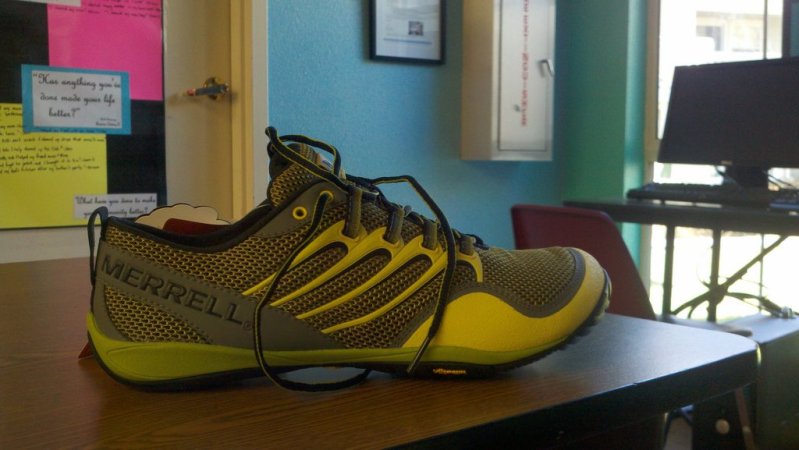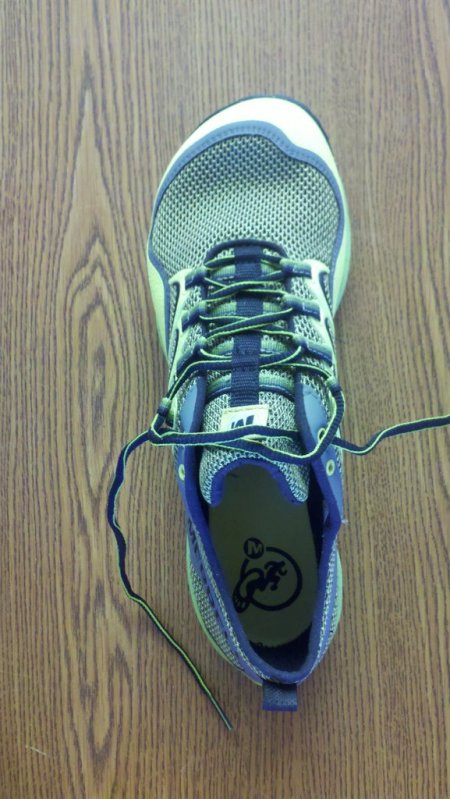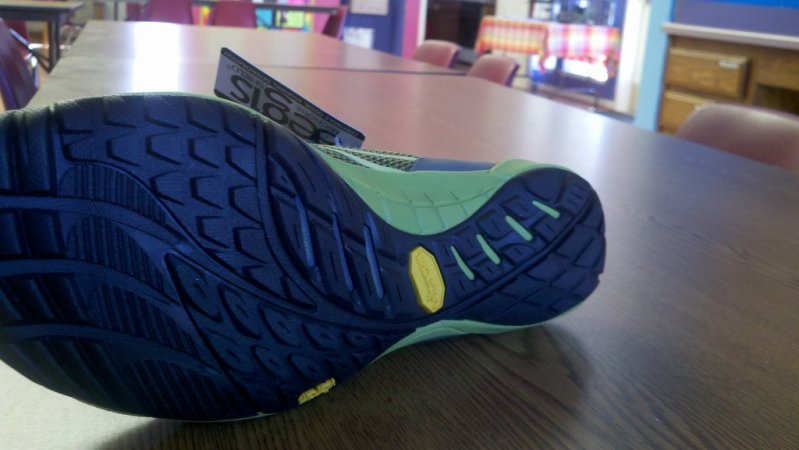I found this video from the Natural Running Store that demonstrates the benefits of a zero drop shoe in a lighthearted and easy to understand way. [youtube=http://youtu.be/prStowbVylE]
Thank you Natural Running Store keep up the good work.
I found this video from the Natural Running Store that demonstrates the benefits of a zero drop shoe in a lighthearted and easy to understand way. [youtube=http://youtu.be/prStowbVylE]
Thank you Natural Running Store keep up the good work.
 The to call the Reebok Realflex a minimalist running shoe, or to say it emulates barefoot running is a real stretch. Much like the Nike Free, the Reebok Realflex is more flexible, more lightweight, and includes fewer support features than the average running shoe, but the toe-to-heel differential alone keeps shoes such as the Reebok Realflex as well as the Nike Free is a slightly different catagory than the most minimalist shoes such as Vibram Five Fingers, Merrel Trail Glove, and the Altra Adam.
The Reebok Realflex, as well as its older brother the Nike Free, are what I like to refer to as "reduced shoes." That is to say, they have some but not all features of minimalist running shoes. In the case of the Reebok Realflex what is missing is a Zero-Drop heel-to-toe differential, as well as a true ground feel.
The to call the Reebok Realflex a minimalist running shoe, or to say it emulates barefoot running is a real stretch. Much like the Nike Free, the Reebok Realflex is more flexible, more lightweight, and includes fewer support features than the average running shoe, but the toe-to-heel differential alone keeps shoes such as the Reebok Realflex as well as the Nike Free is a slightly different catagory than the most minimalist shoes such as Vibram Five Fingers, Merrel Trail Glove, and the Altra Adam.
The Reebok Realflex, as well as its older brother the Nike Free, are what I like to refer to as "reduced shoes." That is to say, they have some but not all features of minimalist running shoes. In the case of the Reebok Realflex what is missing is a Zero-Drop heel-to-toe differential, as well as a true ground feel.
The heel-to-toe differential is the difference in the height of the forefoot of a shoe and the height of the heel of the shoe. In a zero drop shoe this differential is zero. Over the years, running shoes have accumulated more and more heel padding to soften the blow of a heel strike. Though this did make running on your heels more comfortable, it detracted from a natural forefoot stride (notice when running barefoot your heel is not elevated more than your forefoot.) The most minimalist of running shoes have removed the heel to bring it down to the level of the forefoot. Other reduced natural running shoes such as Newtons, or the original Altra, instead of lowering the heel all the way, instead the forefoot was raised to create zero drop heel-to-toe differential.
Because the Reebok Realflex, like the Nike Free, has done nothing to alleviate the heel-to-toe differential I would not classify either as a minimalist or barefoot shoe, but the increased flexibility, and reduced weights show a marked improvement on Reebok's previous line of shoes.
Reebok is marketing the shoe as adding an elevated heel as an improvement on true minimalist shoes, as this cushioned heel will make heel striking more comfortable. As a natural runner however, I am not as interested in comforting my heel strikes as I am in ensuring I don't heel strike in the first place. and, let's face it they did not improve upon a minimalist shoe by adding a heel, Reebok and Nike have both improved upon all their other shoes by making them flexible and lightweight.
Here is the Reebok Realflex promo video, if you are in marketing and enjoy running, after viewing this video I am confident a marketing position will be opening up soon at Reebok.
[youtube=http://www.youtube.com/watch?v=N6h1SMjQEog]
Notice the heel striking even in the promotional video.
[youtube=http://www.youtube.com/watch?v=xyXP2-hYvSs]
 As a minimalist runner I must admit I have been awaiting the Merrell Trail Glove release for quite some time. Not being one to buy shoes without trying them on first, I went to REI the only retailer I could find that I was sure would be carrying the Trail Glove. Apparently size 10 is very popular in the bay area. I was there the day after the release and REI was sold out of size ten. So I tried on the 9 1/2 and the 10 1/2, after about 20 laps around the store and a 15 minutes in the buyers dilemma as to whether or not I should just settle for the 10 1/2, I eventually opted to return home and order size ten directly from Merrell.com. This was a postponed my excitement for another week as I anxiously awaited the arrival of my shiny new Merrell Trail Gloves. This was ultimately the right decision, when I tried on the size ten they fit like a glove, pun intended.
As a minimalist runner I must admit I have been awaiting the Merrell Trail Glove release for quite some time. Not being one to buy shoes without trying them on first, I went to REI the only retailer I could find that I was sure would be carrying the Trail Glove. Apparently size 10 is very popular in the bay area. I was there the day after the release and REI was sold out of size ten. So I tried on the 9 1/2 and the 10 1/2, after about 20 laps around the store and a 15 minutes in the buyers dilemma as to whether or not I should just settle for the 10 1/2, I eventually opted to return home and order size ten directly from Merrell.com. This was a postponed my excitement for another week as I anxiously awaited the arrival of my shiny new Merrell Trail Gloves. This was ultimately the right decision, when I tried on the size ten they fit like a glove, pun intended.
I immediately began to compare the trail glove to the minimalist shoe checklist to ensure I had made the best decision.
 The Merrell Trail Glove performs excellently in this area. It is truly a Zero-drop shoe. This means that the heal to toe differential is 0mm, as opposed to the traditional 12 mm offered by most traditional running shoes. this is number one because I feel this is the most important quality to look for in a minimalist shoe. Grade A+
The Merrell Trail Glove performs excellently in this area. It is truly a Zero-drop shoe. This means that the heal to toe differential is 0mm, as opposed to the traditional 12 mm offered by most traditional running shoes. this is number one because I feel this is the most important quality to look for in a minimalist shoe. Grade A+
 I don't have an unusually wide foot, so this toe box was very generously sized. this is important as a wide toe box will allow the toes to naturally splay upon striking the ground. The toe box was easily as wide as my old school traditional running shoes, and much wider than most racing flats I have encountered on the market. Grade A+
I don't have an unusually wide foot, so this toe box was very generously sized. this is important as a wide toe box will allow the toes to naturally splay upon striking the ground. The toe box was easily as wide as my old school traditional running shoes, and much wider than most racing flats I have encountered on the market. Grade A+
 According to Merrell the sole is made from 4 mm Vibram material. With the exception a 1mm forefoot plate to more evenly distribute weight, there is really nothing else separating the foot from the ground. In my opinion this is exactly the right amout of protection. Now that I have had the oportunity to try them out on some trails, the trail glove makes it easy to travel over sharp rocks and sticks and acorns and poop, protecting the foot without actually altering running stride. Grade A+
According to Merrell the sole is made from 4 mm Vibram material. With the exception a 1mm forefoot plate to more evenly distribute weight, there is really nothing else separating the foot from the ground. In my opinion this is exactly the right amout of protection. Now that I have had the oportunity to try them out on some trails, the trail glove makes it easy to travel over sharp rocks and sticks and acorns and poop, protecting the foot without actually altering running stride. Grade A+
 Upon trying on the Merrel Trail Glove for the first time I did notice that they hug the arch of my foot. this concerned me at first, however, the material hugging the arch is quite flexible providing protection from debris more so than unnecessary arch support. The upper is cut well below the ankle allowing the ankle full range of motion with no interference. Grade A
Upon trying on the Merrel Trail Glove for the first time I did notice that they hug the arch of my foot. this concerned me at first, however, the material hugging the arch is quite flexible providing protection from debris more so than unnecessary arch support. The upper is cut well below the ankle allowing the ankle full range of motion with no interference. Grade A
 The men's Merrell Trail Glove weighs in at about 6.2 ounces. this is about half the weight of my last pair of traditional trainers, but about twice the weight of my Huaraches. I have seen many shoes that are much more lightweight, however, while examining the shoe, I couldn't devise any ways of making the shoe lighter, while maintaining full functionality. Grade B+
The men's Merrell Trail Glove weighs in at about 6.2 ounces. this is about half the weight of my last pair of traditional trainers, but about twice the weight of my Huaraches. I have seen many shoes that are much more lightweight, however, while examining the shoe, I couldn't devise any ways of making the shoe lighter, while maintaining full functionality. Grade B+
 Very, I have only had these shoe for a week and the complements keep coming in. I did of course buy the Amazon colored Trail Glove directly from the Merrell website, (a color not available at REI.) Grade A
Very, I have only had these shoe for a week and the complements keep coming in. I did of course buy the Amazon colored Trail Glove directly from the Merrell website, (a color not available at REI.) Grade A
At 110 dollars the Merrell Trail Glove is the second most expensive pair of shoes I have ever purchased. I must admit the price mad me quite hesitant, however, I have never not gotten my money worth out of a running shoe. I hope as more truely minimalist shoes become available the price will come down to a more reasonable price, still at $110 they are only $20 more than Vibram FiveFingers, and come in $50 less than Terra Plana Evo, and in my opinion the Merrell Trail Glove is a much better shoe than either of those brands. Grade B-
Upon receiving my Merrell Trail Gloves in the mail I canceled my 25 mile tempo run and opted for a hilly muddy 12 mile trail run, ( I never like to try to go to far in my first run in new shoes lest I end up 15 miles out and hobbling home covered in blisters.) Instantly these shoes where amazing, they truly had a barefoot feel. One thing that I instantly noticed is the traction. The traction of the Merrell trail glove is far better than any other minimalist shoe I have ever worn. Along with the shoe not sliding around on the muddy trails, even when wet, my foot didn't slide around in the shoe, a common problem with my huaraches.
These shoes are designed to be worn with no socks. This fact combined with all synthetic materials makes a shoe that does not hold water. In other words, no heavy shoes from running through a puddle.
The only drawback that I have found is that somewhere in the inside of the upper lining of the my left shoe there was a seam that rubbed on my big toe. I didn't notice this until about mile 6, but by mile 10 it was very evident that something was amiss. When I finally removed my shoe, the rubbing had worn through the skin leaving a small hole on the top of my foot.
This is an easy fix with a little tape, of some scissors to give the offender a trim, however, I am in the class that believe you should not have to fix brand new $110 dollar shoes.
So far I only have 100 miles on these shoes, and so far they are holding together excellently, but before I declare these shoes durable they will need to see at least another 400 miles. I will try to follow up when they reach that point.
All in all this is the best shoe I have ever worn. It has all the features needed to make it a great minimalist shoe. But this greatness comes at a price, $110 if you want to put a price tag on it. The only problem is the rubbing on my left toe, I took care of this easily, but hopefully this is something that Merrell will take care of before releasing the Merrell Trail Glove 2.0. Hopefully this is the only thing the change on the Merrel Trail Glove 2.0, unless they can find a magical more light weight material.
Have you tried the Merrell Trail Glove? What did you think? Leave your comments below.
Have you reviewed another minimalist shoe and want it featured on runnaturally.org? Email me and be published.
I first started running when I was in high school. I decided to join the track team because I had a crush on a girl that ran track. What can I say, girls that run track are hot. I only ran my senior year before getting recruited at the college level. All through out college I was plagued every season with injury after injury. Plantar fasciitis, stress fractures, tendinitis, my joints creaked and popped with every step. In those days I never considered form. I thought injury was just a natural part of running, and I was running 70 to 90 miles per week. Despite injury I managed to perform well enough to make it on the national team 4 times and eventually become All-American my senior year. It wasn't until after college that I began to discover the cause of my injuries. It was 2001 while I was attempting to run through a sever case of plantar fasciitis while training for my first full marathon. In college I always just went to the trainer and he would say "Well, ice it and stay off it for a while." This always managed to deal with the immediate problem, but it never confronted the cause.
With no trainer to turn to, and myself studying to become a personal trainer, I did the research on my own. come to find out I, like 75% of shod runners was a heel striker, (a common flaw in shod running populations.) Come to find out, landing on your heels with each stride creates an enormous impact with each stride, (estimated about 3x body weight.) The answer then is to decrease the impact. to decrease the impact I needed to change to a forefoot stride. The process I used to do this is simply running barefoot.
I don't know why I had never considered this before, after all this is how humans ran for about 6 million years. Come to find out, nearly all shod runners that transition to barefoot, not just myself, will naturally transition to a forefoot stride, because when barefoot it is uncomfortable to run on your heels.
Barefoot runners have also noticed it is uncomfortable to run on your heels. Shoe companies have noticed this also and have attempted to fix this by padding the heel. this did make it more comfortable, but it is not the appropriate solution. If it is uncomfortable to run on your heels, don't run on your heels. After I discovered this it just seemed like common sense. If it hurts every time you punch yourself in the face, is it better to put on a boxing glove, or simply to not punch yourself in the face. Perhaps not the best analogy, but I think you get the point.
Transitioning to barefoot was not easy. I started out just a mile at a time, and after each run my calves were sore like I had never used them before, (really I hadn't.) It took months to condition my calves to barefoot running, in the mean time I put in most my miles shod, but focusing on the fore foot strike.
After allowing my body to learn to run barefoot, I then transitioned into minimalist shoes. Running barefoot is an excellent training technique to find natural running form, but running barefoot does admittedly become uncomfortable after a certain number of miles dependent on the terrain. For this reason, I now do most of my running in minimalist running shoes, but on occasion will still run barefoot to ensure I am not altering my natural running form.